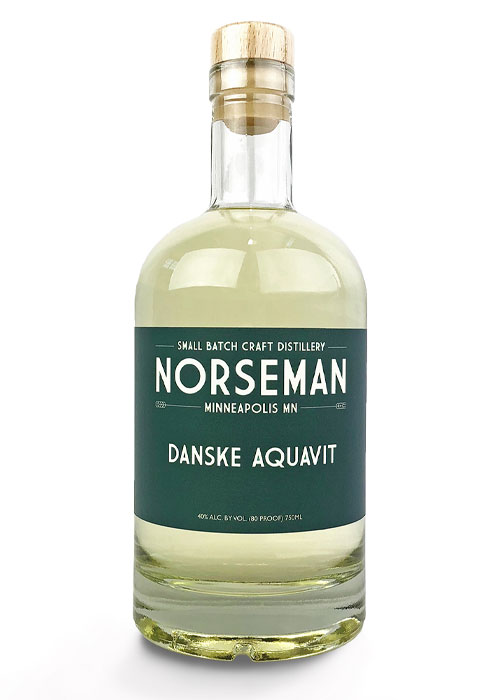This month, VinePair is exploring how drinks pros are taking on old trends with modern innovations. In Old Skills, New Tricks, we examine contemporary approaches to classic cocktails and clever techniques behind the bar — plus convention-breaking practices in wine, beer, whiskey, and more.
Aquavit, an aromatic distilled spirit primarily produced by Scandinavian countries, remains a mystery to many imbibers. Fans love its savory yet slightly tangy flavor, and the growing number of American distilleries producing the juice have raised its profile in the U.S. Still, the spirit still puzzles those outside its fandom bubble, particularly when it comes to using it in a cocktail.
It’s a riddle worth solving. In fact, it’s appropriate that aquavit’s roots are planted in Scandinavia, home of Norse mythology. Aquavit is the Loki of spirits; a shifty substitute that can anchor a plethora of beloved gin and whiskey classics in lieu of their traditional bases. When it’s not imitating gin or whiskey, it can stand out on its own delicious mixed-drink merits. With its multifaceted nature, perhaps no home bar is complete without a bottle of this concentrated mischief. Fully understanding why requires a little exploration.
A Quick Primer on Aquavit
Aquavit (sometimes spelled “akvavit”) is a newcomer amid the American distilling scene — the first bottles started popping up in earnest around the mid-2000s — but it’s been produced in Scandinavia since the 15th century. It starts as a neutral grain spirit like gin, but instead of being infused with juniper berries, it’s infused with caraway and/or dill to meet legal requirements. This baseline imbues the spirit with a savory base that can then be subtly flavored with other ingredients like lemon or orange peel.
The result is delicious, but it also makes trying to find a comparison to other spirits a somewhat slippery proposition. Some bartenders consider its simple yet versatile infused base and slot it in between vodka and gin. Others feel its briny, spicy notes bridge the gap between gin and whiskey. However, those in the know tend to focus on aquavit’s unique flavor profile when educating others — a tactic that can end up resolving customer misunderstandings.
“Some people have this perception that aquavit is sweet like schnapps,” says D.C. bartending legend Chantal Tseng, who runs the cocktail consulting website Custom Cocktails For the End Times. “When you start explaining that it’s more of a neutral grain with botanicals and savory elements, they start to understand what it can do.”
The Spirit World’s Super Sub
Scott Evans, owner of Norseman Distillery in Minneapolis, thinks of aquavit as gin’s Nordic cousin. Yet when he began making the spirit in 2013, he leaned on its flavor flexibility to help satisfy his customers’ thirst for whiskey drinks at his on-site bar. That’s because Minnesota state law forbids the use of non-house-made spirits in distillery bars, and Evans’ whiskey wasn’t ready for prime time. “We used aquavit to make Old Fashioneds,” says Evans. “People loved it, and it ended up being our best-selling cocktail.”
Aquavit’s composition makes it possible for distillers and bartenders to use it as a substitute for a variety of spirits. Its savory, herbaceous backbone — which can be further influenced by ingredients like fennel and clove — allows it to be a seamless whiskey sub, even in burlier drinks like a Boulevardier. At the same time, the fruity and floral botanicals typically added into the mix can carry a nuanced zesty quality that can support the characteristics of refreshing gin drinks like a Gimlet or a Tom Collins. Its complex mélange can also provide added punch to drinks normally made with a vodka base. “A Bloody Mary with aquavit is a no-brainer,” explains Tom Richter, East Coast national spirit specialist for Craft Spirit Cooperative in San Francisco. “By swapping vodka with aquavit, you’re adding additional herbs and spices into the mix, which makes it a far more interesting drink.”
This versatility does come with a catch: Its reputation as a cocktail chameleon has arguably hindered the opportunity for an internationally recognized aquavit-based drink — and aquavit in general — to capture the public’s imagination. “What aquavit doesn’t have is its own signature cocktail to help it catch fire, like whiskey had with the Old Fashioned,” Evans said. “People may get into it more easily if it had its own well-known platform.”

Using Aquavit at Home
The first step in adding aquavit to your home bartending repertoire is to understand where it’s coming from. While American aquavit can carry a wide range of styles, Scandinavian aquavits carry distinctions based on their country of origin. “Norwegian aquavit’s aged in wood, giving it a darker color,” Richter says. “Swedish aquavit’s unaged and a little more delicate than Danish aquavit, which tends to have more aggressive flavors.” Because of this variance, don’t be afraid to pick up a few different bottles to determine your preference.
Once you’ve found a couple bottles you like, start swapping aquavit with the base spirit in a few easy-to-make drinks, like an Old Fashioned or a Negroni. When you’re comfortable enough, you can turn your home bar into an R&D kitchen by scouring the internet for inspiration and building beverages featuring more advanced ingredients. “Aquavit can hold up to anything — vermouth, amaro, sherry, you name it,” Tseng says. “That’s what makes it so fun to use.”
It can also hold up to food; the pros point out that the base botanicals make aquavit cocktails ideal pairings for an eclectic range of dishes, from Nordic-inspired fare like smoked fish to comfort food like fried chicken.
One more thing to bear in mind: It’s always a good idea to be fearless in your at-home creativity. If you’re worried that an aquavit cocktail may not come out quite as well as you hoped, don’t fret. Remember that aquavit, like Loki, is a mischievous spirit of remarkable malleability. Even if the drink you make doesn’t match what you had envisioned, chances are, it will still excite your taste buds with its unique profile.

